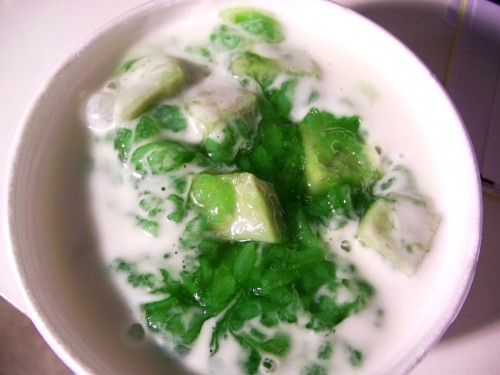 Do you have those times when you keep craving something sweet, even after you wiped clean a cereal bowl worth of Double Fudge Brownie, exterminated many prunes, and skillfully chewed up four pirouette cookies like a mafia boss smoking cigars? I’ve started to see such danger of staying up late, but sweet stuff is always easier to eat than savory stuff in those wee hours. To avoid having my belly exceed my face, I started going through pictures of food (it helps more than studying and thinking about food), and found some munchtastic sweet treats I meant to but never got around to blog about. 1. Chè khoai môn (taro che) One of the few country treats without mung bean paste. Depending on each root and how long it’s cooked, the purplish pale taro cubes can be grainy, nutty, a little chewy, or al dente, like scallop potato minus the butter. However they are, they serve as a textural contrast to the gooey pudding-like sticky rice base. I’m particularly charmed by the vibrant green color in this Lee’s Sandwiches‘ rendition, hopefully from pandan leaf extract. You know it’s a skilled cook when the […]
Continue reading More starchy sweets
 Sitting still, it looks like a rock. It is sweet with a hint of lard. It is chewy with a weak crunch, similar to a lasagna’s crust. The smooth, thick black skin shines like lacquered wood, but possesses an almost clear and cool embrace of jello. Though closely related to the superglutinous and mud-heavy banh it, banh gai takes it light. The same everenduring stuff of Vietnamese villagers’ creations are thrown together, wrapped and steamed in banana leaves: sticky rice flour, water, mung bean paste, sugar. If you make it in cone shape and let the sugar brown the flour naturally, you get banh it. Go the extra mile of picking, chopping, sun-drying, boiling, and grinding the ramie leaves to a black powder that you would mix with your sticky rice flour in a 1:10 ratio, then after the fire settles you get banh gai. Actually, you get the skin of banh gai. The thorny ramie leaves with silver underside give the black buns their color and trademark names, “thorn leaf banh it” (bánh ít lá gai), “thorn leaf banh” (bánh lá gai), or, most economically, “thorn banh” (bánh gai). […]
Continue reading Sandwich Shop Goodies 1 – Banh gai (thorn leaf bun)
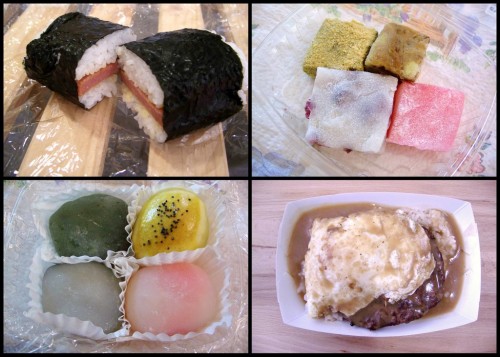 One blue-sky Sunday in May. A section of Channing Way, between Shattuck and Fulton, was blocked. Two girls draped in summery garments danced to joyous Hawaiian tunes on a sunlit wooden stage, surrounded by a small crowd of both familiar spectators and curious passing pedestrians. The seductive smell of grill beef got caught in the wind here and there. So it was the street front of the 61st annual Satsuki Bazaar and Arts Festival at the Berkeley Jodo Shinshu Buddhist Temple on Channing Way. Inside the temple, a multitude of items displayed for silent auction held visitors’ footsteps, starting with orchids, matted photos and paintings, gift cards to sushi bars and diving lessons… …to porcelain sets, stuffed toys, a wooden sculpture of Daruma, and Shichi Fukujin in a glass box. Continue reading Satsuki Bazaar on Channing Way
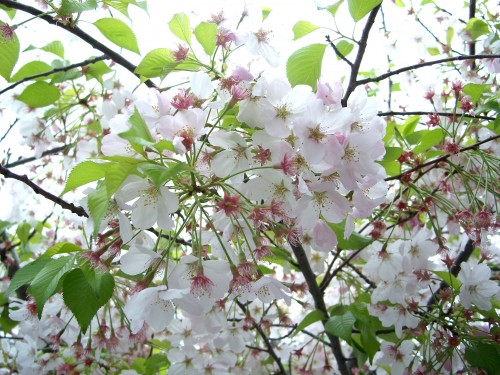 One Saturday we shove our homework into a corner and make a dash for San Francisco before another spring storm takes over the bay. Parking is as easy as hiking with a twisted ankle, but all that matters is we find a spot, then stroll a mile to the food bazaar on Webster street, Japan Town, arriving just a little bit before noon. Up from the steep sidewalk we see rows of white tents and white chairs, smoke rolling above the grills covered with beef and pork riblets, a line getting long on one side of the conglomeration. It is still early in the first morning of the Cherry Blossom Festival. The carnivore instinct leads me right to the grill. It’s never too early to eat meat. The first booth whips out rice bowls with either ribs or unagi, braised eel cut into palm long chunks. We don’t feel like filling up with a rice bowl just yet, so we walk further down the row eying signs, then back track to the Nihonmachi Little Friends’ booth for three skewers of grilled beef at a mere five bucks. Continue reading When the blossoms bloom
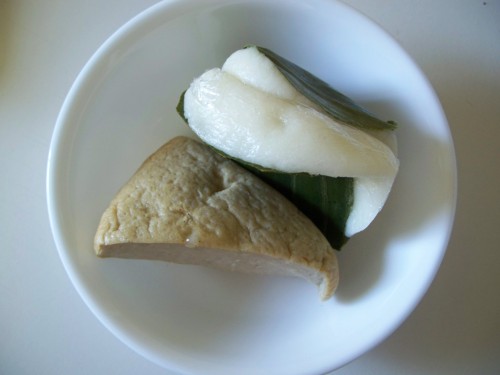 It’s just a white bun made from sticky rice, loosely wrapped in banana leaf so that it doesn’t attach indefinitely to your fingers, ready to sandwich a thick cut of cha lua. The purpose of the bun is purely a textural enjoyment, it has neither taste nor smell. All flavors come from the sausage. Eating the bun alone would be like chewing an incredibly huge piece of gum, the only difference is you can swallow the bun. Come to think of it, we can make a bunch of bite size sticky rice “gum” for American school kids, they can chew until they’re bored, and swallow it, no unfortunate mess under the desks and your shoes. Cool, innit? Because of either its simplicity or its antiqueness, the bánh dầy is not quite a favorable snack among the young Vietnamese these days. Or perhaps because it is a treat from the North? Southerners have a sweet tooth and are attracted to fatty, rich, flavor-compact concoctions. Bánh dầy is none of that. When I was in Saigon I knew of bánh dầy through three sources: the extremely common tale of bánh chưng bánh dầy, the book “Hanoi 36 streets” by […]
Continue reading Bánh dầy giò – sticky rice bun with sausage
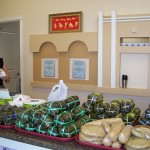 Given how often my family comes here, I feel obliged to give this store a proper post. About every other week or so, my parents make the hour-long drive to get a loaf or two of cha lua (silk sausage) and maybe a few Vietnamese between-a-snack-and-a-meal goodies. The affable owner lady knows our usual grabs, and we know her trustworthy provision. Whether it’s wrapped in banana leaves, aluminum foil, or cling wrap, Giò Chả Đức Hương has the best of its kind in Bellaire. The shelves of nem (fermented pounded pork sausage), bánh tét (sticky rice log), and bánh ít (sticky rice pyramid). These small bánh tét are sold all year round, they are only about 4 inches long, usually with vegan filling (mung bean paste or banana). They make an appropriate snack for a teenager, but usually a little too much for me. Unwrapped below, left-right-down: bánh giò – bánh ít – bánh tét: Continue reading Giò Chả Đức Hương – sausage and so much more
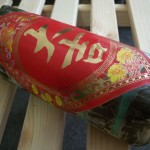 Bánh chưng and bánh tét to the Vietnamese Tết are like turkey and ham to the American Thanksgiving. The holiday feast just wouldn’t feel right without them. Although I have blogged about these sticky rice squares and logs before, the lunar new year has come back, and so are they. Sticky rice can be uberfilling in large quantity, and like all festive food, it’s not recommended that you feast on these dense beasts day after day, as satisfaction would turn into tiresomeness. But once a year, or maybe twice, a couple slices of banh tet sound so much more interesting than cereal, rice, even noodle soup. Banh chung and banh tet have rather similar ingredients, especially when they’re made by Vietnamese Southerners. Both are wrapped in leaves (although slightly different kinds of leaves), and boiled for hours in water that is sometimes spiced with lemongrass. After cooking, a heavy weight is put on banh chung to drain the water, while banh tet are rolled around to perfect the cylindrical shape. I remember we used to hang pairs of banh tet in my grandfather’s kitchen, taking one down everyday during the week of Tet to whip out a nice […]
Continue reading Banh tet, sweet and savory
 You know how school kids don’t get tired of peanut butter sandwich even if they eat it every day for lunch? Well, every time I catch the BART down to Fremont, it’s hard to pass up the chance to stop by Huong Lan Sandwich in Milpitas for a fresh crusty loaf, or many of those banh mi’s – a week’s supply for lunch. When in California, be liberal. The store has diversity. Above is packages of bánh bèo (white) and most likely bánh bột lọc (leaf-wrapped). Many kinds of cookies, crackers, shrimp chips, and other snacks unknown to ubercmuc. Below is the real goodies: nice warm bánh bao (steamed pork bun), bánh cốm (the bright green flat thing), bánh giò (leaf-wrapped pyramid), and mini bánh chưng (the squares). Here’s the square unwrapped and cut in four. The pork is fatty, which is not quite right, but nonetheless it’s well done. So the story goes as follows: in a competition among the princes in ancient Vietnam, the king asked all the princes to find […]
Continue reading Banh mi run
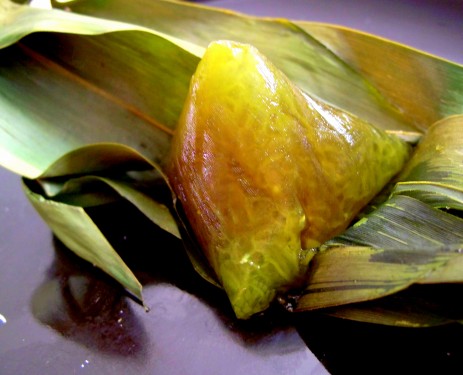 The recipe calls for a lot of prep time (up to a year!), and the products are little triangular pyramids sold for $3.75 a bunch at sandwich shops. But hey, if you can make bánh ú tro, you can enjoy it any time of the year without having to wait until the Fifth of Lunar May. 1. Ash water Use the fine, soft ash from burnt coal, dissolve in water. The common ratio is 50 grams of ash for every liter of water, but it varies depend on how strong the ash is and how strong you want your banh to be. Let the ash collect at the bottom, leaving a clear solution. Sift the solution to get rid of dirt and coal bits. You can use lime powder instead of ash. White lime gives bánh ú tro the natural green hues of wrapping leaves, red lime gives them reddish amber hues. The mixing ratio is 20 grams/liter for lime powder. Continue reading Recipe for Bánh ú tro (Vietnamese-adapted jianshui zong)
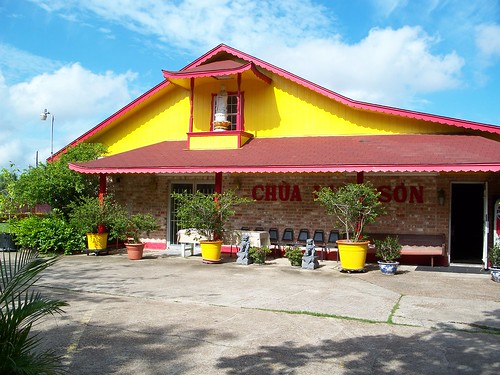 Linh Son pagoda, Houston, click on the image to see more pictures of the pagoda. Linh Son pagoda, Houston. Click on the image to see more pictures of the pagoda. Although not all Vietnamese living oversea can take a day off to go to the pagodas on the first day of Tet, many manage to keep the tradition. Of course there is no strict requirement that one has to be looking at and praying to the Buddha at a certain day, for a certain amount of time, or with a certain prayer. Tet is not a religious based tradition. But many Buddhist and even non-Buddhists like to go to the pagodas on the first day of Tet to have a peaceful start of the new year, to feel spiritually lightened (hopefully enlightened as well) and pure on the important day. Many also choose to eat no animal product on this day, as it’s the new spring and every creature deserves to be happy and live in peace. Nonetheless, vegan restaurants are somewhat scarce in the conservative town, places with banh chung banh tet for sale don’t generally make the vegan version, and to deprive […]
Continue reading Linh Son Pagoda’s banh for the Lunar New Year
|
|
Blogs we read
|











